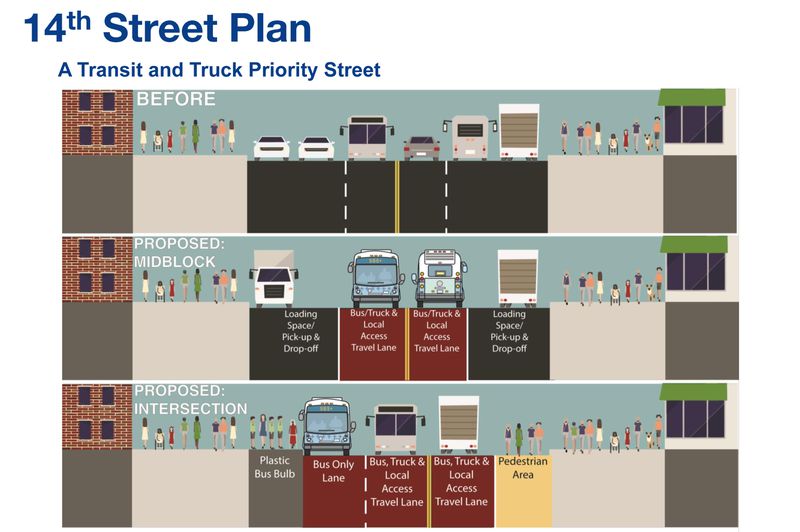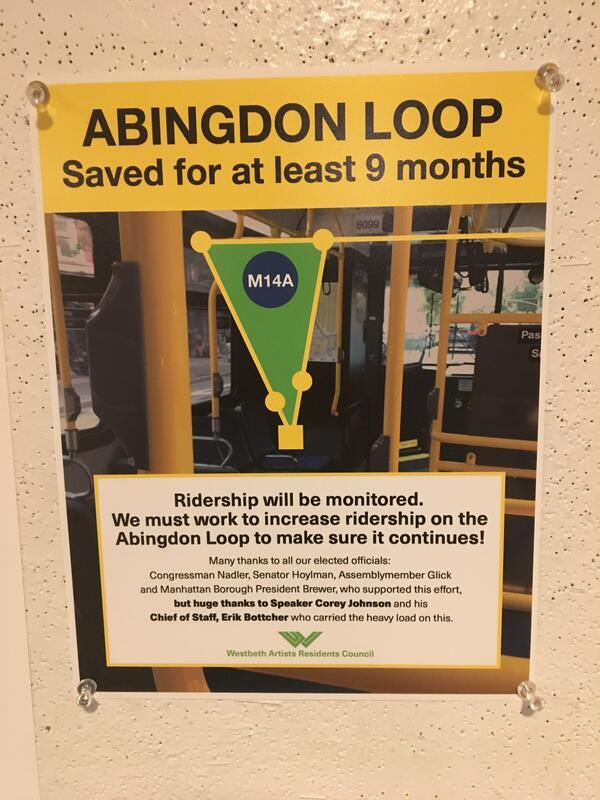BY LINCOLN ANDERSON | The city’s “experiment” on 14th St. is set to kick off Mon., July 1, as through traffic will be banned between Third and Ninth Aves. and buses and trucks will rule the road.
On the same day, the M14A and M14D routes will be converted entirely to Select Bus Service, with a total of 16 bus stops eliminated and curbside payment instituted to speed up bus times.
It’s all part of what’s being called a pilot project — albeit one slated to last a full year and a half.
And in a huge relief to West Village seniors, the Metropolitan Transportation Authority has agreed to wait for nine months to decide on whether to ax the Abingdon Square loop at the western end of the M14.
The Department of Transportation announced the changes on Mon., June 9, the Daily News reported.

Under the first-of-its-kind plan in New York City, cars and cabs would be able to come onto 14th St., but only for one block for pickups and drop-offs, and would then have to leave the crosstown boulevard at the first available right-hand turn. Cars would also be allowed onto 14th St. to access garages. Left turns along this stretch of the crosstown street would not be allowed.
The prohibitions on cars would be in effect from 6 a.m. to 10 p.m. every day.
Moving traffic would be reduced to one lane in each direction. Midblock next to the curb, there would be extra-wide space for loading, pickups and drop-offs. At intersections, there would also be a third, separate lane for a bus stop, and the curbside space in this area would be reduced.
The scheme was previously called a “busway” when it was pitched as part of the transit mitigation plan for the L-train full shutdown plan. But this past January, Governor Andrew Cuomo nixed the full L-train shutdown and said the L line’s Sandy-damaged East River tubes could be repaired on nights and weekends, with one tube always left open allowing for partial service.
At that point, the busway appeared kaput. But, in April, the idea was resuscitated, in a slightly different form, and redubbed “Transit/Truck Priority” lanes.
Meanwhile, repairs on the L-train tunnel started in late April.
D.O.T. will enforce the new T.T.P. lanes with cameras along 14th St. But enforcement measures won’t kick in until at least 60 days after the traffic changes go into effect. There will reportedly also be new traffic signals, known as Transit Signal Priorities, with technology to detect when a bus is nearby and adjust the length of red or green lights, so that buses spend less time waiting at lights.
The Daily News reported that the intention is to have seven new Police Department tow trucks patrolling 14th St. — targeting double-parking, for one — as part of the effort to enforce the new regulations.
The T.T.P. scheme on 14th St. would be the first of its kind in the city.
Just as they feared with the busway, many local residents living nearby in the Village and Chelsea continue to worry that displaced car traffic and ride-hail app cars will flood their small side streets if the through-traffic ban on 14th St. goes into effect.
A D.O.T. spokesperson explained to this paper the reasoning behind implementing the daily ban on cars and cabs from 6 a.m. to 10 p.m.:
Bus ridership “rises significantly” starting at 6 a.m., he said, while evening ridership decreases more gradually. Also, during the L-tunnel repairs, the M.T.A. has operated the M14A at “increased frequencies” after 8 p.m., which the T.T.P. plan — which ends at 10 p.m. — “would support.” In addition, the spokesperson pointed out, bus speeds drop in the early morning and remain slow throughout the day and evening — another justification for implementing the T.T.P. plan. Finally, overall traffic speeds remain “consistently low” on 14th St. throughout the day, “particularly at midday” — with this having been true before and also now during the L-train repairs.
The Riders Alliance, one of the city’s leading transportation advocacy groups, hailed the launch of what it termed a “busway.” Although the plan hasn’t even been implemented or tested yet, the Alliance is already eagerly calling for it to be replicated citywide.
“The 14th St. busway is great news for transit riders and neighborhood residents,” declared Danny Pearlstein, the group’s communications director.
“By ensuring fast, reliable transit starting July 1, the busway will provide an excellent alternative to jam-packed L trains and expensive, inefficient car trips.
“New Yorkers across the city should be grateful to Mayor de Blasio and New York City Transit Authority President Andy Byford for putting this innovative service in place. We look forward to working with our elected leaders to ensure that buses are prioritized on more streets across the city, so riders everywhere get where they need to go.”

West Village seniors — including many living in Westbeth Artists Housing — had been in a panic after the M.T.A. recently announced it would be cutting out the Abingdon Square loop at the western end of the M14 route. However, at the urging of local politicians, the agency has now reportedly granted a reprieve, saying it will keep the loop for at least nine months after the new 14th St. scheme goes into effect and “study” the situation.


































